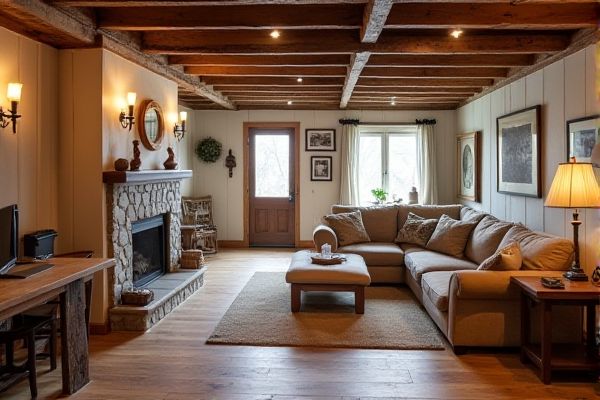
Radiant heat systems provide consistent, energy-efficient warmth by heating floors directly, while forced air systems distribute heated air through ducts, which can cause uneven temperatures and dust circulation in basements. Explore this article to determine which heating option best suits your basement comfort needs.
Table of Comparison
| Feature | Radiant Heat Basement | Forced Air Basement |
|---|---|---|
| Heating Method | Heat is emitted through electric or hydronic tubing under floors | Heated air is circulated through ductwork by a furnace or heat pump |
| Energy Efficiency | High efficiency due to direct heat transfer, reducing heat loss | Lower efficiency, heat loss occurs via ducts and air leaks |
| Comfort | Even, consistent warmth; no drafts or cold spots | Variable heat distribution, possible drafts and uneven temperatures |
| Installation Cost | Higher upfront cost; requires floor installation or slab work | Lower initial cost; easier to retrofit existing duct systems |
| Maintenance | Low maintenance; system is generally reliable and long-lasting | Regular filter changes and duct cleaning needed |
| Air Quality | Improves indoor air quality by not circulating dust or allergens | May circulate dust, allergens, and require filtration |
| Heat Response Time | Slower to heat up but maintains heat longer | Quick heat delivery but can cool rapidly |
| Noise Level | Silent operation | Noisy due to blower and ductwork |
Introduction to Basement Heating Options
Basement heating options primarily include radiant heat and forced air systems, each offering distinct advantages in temperature control and energy efficiency. Radiant heat provides consistent warmth through floor or wall heating elements, reducing cold spots and improving comfort. Forced air systems distribute heated air via ducts, enabling faster temperature adjustments but may result in uneven heat distribution and increased energy use.
Understanding Radiant Heat Systems
Radiant heat systems deliver warmth directly to your basement floors or walls using heated water or electric coils, creating consistent and energy-efficient heat without the noise of forced air blowers. Unlike forced air systems that circulate warm air through ducts, radiant heat minimizes dust circulation and provides even temperatures throughout the space, enhancing comfort and air quality. Choosing radiant heat for your basement can improve energy savings and maintain a cozy environment ideal for living spaces or storage areas.
Overview of Forced Air Heating Systems
Forced air heating systems use a furnace to heat air, which is then distributed throughout the basement via ductwork and vents. These systems provide rapid heat delivery and allow for easy integration with central air conditioning and air filtration. However, forced air can create uneven temperature zones and may circulate dust and allergens, impacting indoor air quality.
Energy Efficiency Comparison
Radiant heat systems provide superior energy efficiency in basements by delivering consistent, even warmth directly through the floor, reducing heat loss and minimizing energy waste compared to forced air systems. Forced air relies on ductwork, which often leads to heat loss and uneven temperature distribution, decreasing overall system efficiency. The energy savings from radiant heat can be substantial, especially in well-insulated basements, making it a cost-effective solution for long-term heating.
Installation Process and Costs
Radiant heat installation in basements involves embedding tubing or electric mats beneath the floor, often requiring subfloor removal, which can increase labor and material costs compared to forced air systems. Forced air basements utilize ductwork installed in walls or ceilings, making the process quicker and generally less expensive, but may require additional components such as furnaces or air handlers. Your choice impacts upfront expenses, with radiant heat typically costing more initially but providing efficient, even warmth that can reduce long-term energy bills.
Comfort and Heat Distribution
Radiant heat provides consistent warmth by evenly distributing heat through floors, creating a comfortable environment without cold spots or drafts common in forced air systems. Forced air heating relies on ductwork to circulate warm air, which can result in uneven temperature distribution and fluctuating comfort levels. Radiant heat's ability to maintain steady, uniform temperatures enhances overall basement comfort compared to the variable warmth of forced air systems.
Air Quality Considerations
Radiant heat systems in basements provide superior air quality by reducing the circulation of dust, allergens, and airborne pollutants commonly circulated by forced air systems. Forced air heating relies on blowing heated air through ductwork, which can accumulate and distribute dust mites, mold spores, and other contaminants, potentially aggravating respiratory issues. Radiant heating eliminates these concerns by warming surfaces directly, promoting a cleaner and healthier indoor environment ideal for sensitive individuals.
Maintenance Requirements
Radiant heat systems in basements require minimal maintenance, primarily involving occasional inspection of the boiler or heating element and checking for leaks in the tubing. Forced air systems demand regular filter changes, duct cleaning, and periodic inspections to ensure the blower and thermostat function efficiently. Choosing radiant heat can reduce your maintenance workload while providing consistent warmth without the dust and allergens commonly circulated by forced air.
Long-Term Operating Costs
Radiant heat systems in basements offer lower long-term operating costs due to their energy-efficient design, providing consistent warmth by heating surfaces directly rather than air. Forced air systems typically incur higher expenses over time because they lose heat through ductwork leakage and require more frequent maintenance. Investing in radiant heat can result in substantial savings on utility bills and reduced wear on heating components over the lifespan of the system.
Choosing the Best Heating System for Your Basement
Radiant heat systems offer consistent, energy-efficient warmth by directly heating floors and objects, making them ideal for basements with limited ceiling space. Forced air heating provides quicker temperature adjustments and integrates well with existing HVAC setups but can cause uneven heat distribution and increased dust circulation. Selecting the best heating system depends on factors like basement insulation, ceiling height, air quality concerns, and energy efficiency goals.
 homyna.com
homyna.com